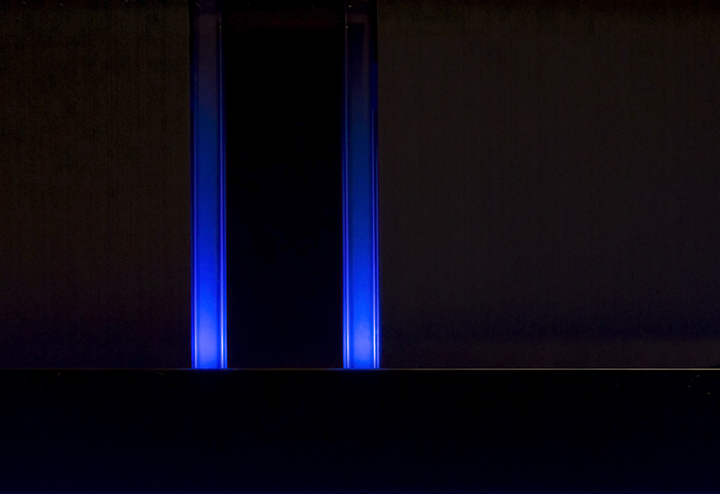Time Out for from Alaska
New Computer
05/7/2016. I found the right computer. It came with free air fare to Antarctica. I wanted either a fast Xeon- or i7-based machine, something built around a CPU and other components well represented in the Pixinsight benchmarks. My target machine was something with an i7-4790k CPU (4 cores / 8 threads) with at least 16GB of RAM. I counted on adding at least a 256GB SSD if it didn't already have one and probably adding RAM.

Indicator LEDs glowing deep blue show the CPU at idle.
What I found was a factory-refurbished Hewlett-Packard 850-se built around an i7-5820k (6 cores / 12 threads), with 32GB of RAM, and a 512GB SSD running Win7 Pro. Bluff called. It's sold as a gamer's PC, but it's spec'd even better for my needs. It was priced in line with what a new 4790k with upgrades would have cost, but has a CPU whose extra cores and threads can be put to work very nicely by Pixinsight. Gamers, I am told, might prefer the 4790k which can be clocked even faster and because the 5820k's extra cores don't benefit several popular games. This one is very close to a turnkey solution for me. I looked at a new Mac Pro but for similar performance the price was 3-4x higher; I tried to spec a new HP-850 or -860, but SSD's weren't among the available options, and again, the price.... (Also, does it actually make more sense to buy a factory-refurb? The new ones are basically stamped out; the refurbs have had humans actually work with them.)
While I hemmed and hawed, the seller of the machine I was considering (a dealer in Brooklyn, not some kid disappointed with his gamebox) dropped its price by $50. That doesn't sound like much, but it covered a used 20-inch Dell monitor (I'm keeping my calibrated 24-inch, of course, but using it with my notebook as my main computer has addicted me to dual screens; the HP supports at least three, so look out).
With just a little tuning (reserve 6.5GB of RAM for a RAMdisk, give PixInsight 8 pointers to its swap files, use the factory-provided overclocking tools to boost the water-cooled CPU from 3.3 to 3.8Ghz), it's sitting in 8th place overall and 1st place among i7-5820k boxes on the PixInsight benchmark. The swiftest machines (Xeon-based boxes with 64-128GB RAM and running under Linux) are about 50% faster. The standard suite that took my old machine 7m42s takes this one 48.5 seconds [defining 12 pointers to the RAMdrive, one for each thread, took another second off: now 47.5, but who's counting?]. In real-world image processing, that's the difference between a 2-hour slog through a pile of subexposures and a 10-minute waltz. (With longer subexposures, my deep sky post-processing for any given sky depth could easily be 20-30x faster.) I've reprocessed some solar images: from raw video to a decently finished final frame takes about three and a half minutes (allow one minute for dithering around with options) which compares very nicely to twenty to thirty minutes before (also allowing one minute for...).
Nor is speed just a matter of executing rote processing more quickly: when experiments take seconds, you can try things. I'm defining an improved workflow for solar imaging by trying several variations of denoise, deconvolution, and histogram adjustments: the order and the parms all matter, and an hour spent twisting dials accomplishes what would have taken confusing days of trial and error and error and error... [no show and tell yet].
I'm slightly miffed that HP's factory info says this machine maxes out at 32GB while I've seen threads that suggest it will accept 64GB. 32GB is probably plenty, but still... I added a USB3 BlackX box to host two external drives and replaced the squishy el cheapo OEM keyboard with a wireless Apple keyboard and touchpad. The keyboard and touchpad are joined perfectly using a 3rd party adapter, and the keyboard benefits from third party software interception to provide both delete and backspace functionality (among other things). Links to come. I love this keyboard!
As if new projects with Pixinsight weren't incentive enough, I finally learned to turn Canon 6D stills into timelapse animations (Duh! It's Easy!).
Comet Lovejoy Timelapse on Vimeo
Pixinsight needs a chance to work its wonders on many, many old images as well as whatever new ones I acquire. I have plenty of archived solar video to refine in AviStack and Pixinsight. Terragen, which is also on the order of ten times faster, will be a lot of fun to mess around in. All those apps will use every cycle this machine has to offer.
It will get it's first original action, weather willing, when Mercury transits the Sun on May 9.
As for Antarctica, I paid for this with the Citi/AAdvantage card American Airlines cajoled me into signing up for while I commuted between gates in Phoenix. It's supposed to come with 50,000 frequent flier miles if I spend a certain amount in the first three months. This machine will just about do it, and those miles added to my current stash of miles (hoarded and protected since 1986, boosted with Alaska this year) will bring my account's total up to the point that Amy and I can do Paris (or just about any other European or American destination) and I can fly to Ushuaia, Argentina. Airfare isn't the majority of the cost of doing Antarctica, but it's no small part of it.